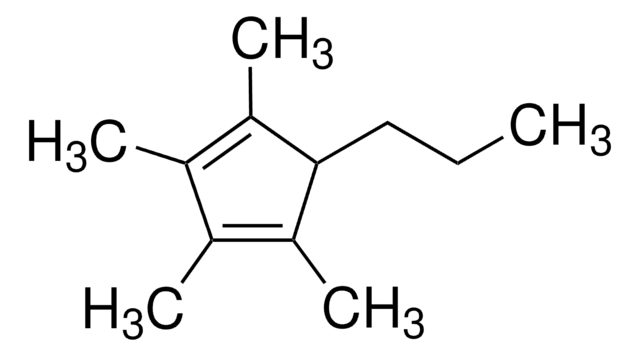Key Documents
703214
Di-tetrabutylammonium cis-bis(isothiocyanato)bis(2,2′-bipyridyl-4,4′-dicarboxylato)ruthenium(II)
95% (NMR)
Synonim(y):
Greatcell Solar®, N-719 dye
About This Item
Polecane produkty
Poziom jakości
Próba
95% (NMR)
Postać
powder
skład
Dye content, ≥90% HPLC
mp
250-260 °C
λmaks.
534, 393, 313 nm (lit.)
ciąg SMILES
S=C=N[Ru]N=C=S.CCCC[N+](CCCC)(CCCC)CCCC.CCCC[N+](CCCC)(CCCC)CCCC.OC(=O)c1ccnc(c1)-c2cc(ccn2)C([O-])=O.OC(=O)c3ccnc(c3)-c4cc(ccn4)C([O-])=O
InChI
1S/2C16H36N.2C12H8N2O4.2CNS.Ru/c2*1-5-9-13-17(14-10-6-2,15-11-7-3)16-12-8-4;2*15-11(16)7-1-3-13-9(5-7)10-6-8(12(17)18)2-4-14-10;2*2-1-3;/h2*5-16H2,1-4H3;2*1-6H,(H,15,16)(H,17,18);;;/q2*+1;;;2*-1;+2/p-2
Klucz InChI
MQGCPZMVNHGIPF-UHFFFAOYSA-L
Opis ogólny
Zastosowanie
Informacje prawne
Greatcell Solar is a registered trademark of Greatcell Solar Materials Pty Ltd.
Hasło ostrzegawcze
Danger
Zwroty wskazujące rodzaj zagrożenia
Zwroty wskazujące środki ostrożności
Klasyfikacja zagrożeń
Resp. Sens. 1
Kod klasy składowania
11 - Combustible Solids
Klasa zagrożenia wodnego (WGK)
WGK 3
Temperatura zapłonu (°F)
Not applicable
Temperatura zapłonu (°C)
Not applicable
Środki ochrony indywidualnej
dust mask type N95 (US), Eyeshields, Faceshields, Gloves
Wybierz jedną z najnowszych wersji:
Masz już ten produkt?
Dokumenty związane z niedawno zakupionymi produktami zostały zamieszczone w Bibliotece dokumentów.
Klienci oglądali również te produkty
Produkty
Ruthenium-Based Dyes for Dye Solar Cells
Dye-sensitized solar cells directly convert sunlight to electricity
Over the last decade, dye-sensitized solar cells (DSSCs) have attracted much attention because these unconventional solar cells exhibit high performance and have the potential for low-cost production.
One of the more traditional photovoltaic devices, single crystalline silicon solar cells were invented more than 50 years ago, currently make up 94% of the market. Single crystalline silicon solar cells operate on the principle of p-n junctions formed by joining p-type and n-type semiconductors.
Nasz zespół naukowców ma doświadczenie we wszystkich obszarach badań, w tym w naukach przyrodniczych, materiałoznawstwie, syntezie chemicznej, chromatografii, analityce i wielu innych dziedzinach.
Skontaktuj się z zespołem ds. pomocy technicznej











